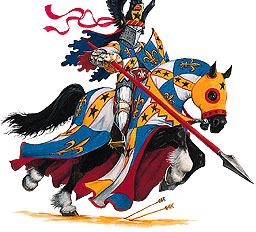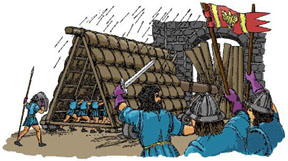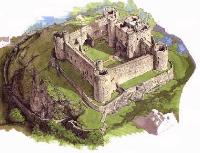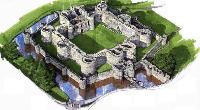 "Local
topography affected where a castle was to built as it assisted in
defence as well as raising a commanders moral. Castles not only
over looked nearby roads and bridges, their missiles also
prevented movement along these routes. A longbow had a range of
about 200m and a spring crossbow could fire its heavies armour
piecing bolt some 400m in the hands of a skilled marksman.
Catapults artillery had a similar range, both distance and
striking power enhanced by gravity - the same natural force which
was a disadvantage for archers down at ground level firing
upwards."
"Local
topography affected where a castle was to built as it assisted in
defence as well as raising a commanders moral. Castles not only
over looked nearby roads and bridges, their missiles also
prevented movement along these routes. A longbow had a range of
about 200m and a spring crossbow could fire its heavies armour
piecing bolt some 400m in the hands of a skilled marksman.
Catapults artillery had a similar range, both distance and
striking power enhanced by gravity - the same natural force which
was a disadvantage for archers down at ground level firing
upwards."
"Nor can an invading army try to hurry
past, accepting casualties but otherwise ignoring the fortress.
There were often in Legion castles a garrison of knights ready to
fall upon the rear guard and to bar the line of retreat. So the
castle had to be captured. The invaders had to bring everything
with them, or else waste time and effort foraging the
countryside. Inside the castles were warm hearths, dry clothes,
hot meals, a comfortable bed at night, proper sanitation. Outside
was rain, snow, mud and wet feet and stones beneath the sodden
blankets."
"One of the most popular ways of
conquering a castle was to completely surrounding and thus stop
and supplies reaching the defenders. One of the main advantages
of this was that the attacking force's casualties was much lower.
However, a siege like this could only be carried out if the
attacker had the time to lay siege like this for a number of
months, or even longer, waiting for the defenders moral to fall
as well as their supplies. Many of Legio Mortis' commanders did
not have this luxury of time and a number of processes were
devised to speed up this process. Also, many larger castles had
vast supplies which could last them a very long time."
 "One of the most
popular weapons employed during sieges was the trusty catapult,
shown on the left here. These types of catapults, known as
mangonels, used the tension created by a wooden beam placed
between twisted ropes or hair to hurl large tones through the
air. Catapults where also used by the defenders sometimes, to
destroy the siege weapons being used by the attacks, which due to
their range, was also within bow shot. The three major types of
catapults are the ballista, mangonel and trebuchet."
"One of the most
popular weapons employed during sieges was the trusty catapult,
shown on the left here. These types of catapults, known as
mangonels, used the tension created by a wooden beam placed
between twisted ropes or hair to hurl large tones through the
air. Catapults where also used by the defenders sometimes, to
destroy the siege weapons being used by the attacks, which due to
their range, was also within bow shot. The three major types of
catapults are the ballista, mangonel and trebuchet."
 "The
ballista is the oldest form of catapults. It uses twisted ropes
that held the 2 arms of a giant crossbow. Some early commanders
used the tension of a single large bow arm. A winch or sometimes
a wooden screw pulled back the sliding tiller to draw the cord.
The ballista was an anti personnel weapon weapon and was useful
to the besiegers in discouraging sorties against them as the
ballista could easily be used to pick off the enemy attackers.
The ballista was a favourite of defenders beers it could be
mounted on a unmodified tower. It was very accurate and had
a long range, but was
"The
ballista is the oldest form of catapults. It uses twisted ropes
that held the 2 arms of a giant crossbow. Some early commanders
used the tension of a single large bow arm. A winch or sometimes
a wooden screw pulled back the sliding tiller to draw the cord.
The ballista was an anti personnel weapon weapon and was useful
to the besiegers in discouraging sorties against them as the
ballista could easily be used to pick off the enemy attackers.
The ballista was a favourite of defenders beers it could be
mounted on a unmodified tower. It was very accurate and had
a long range, but was
limited to line of sight."
"One of the most common forms of catapults
was the trebuchet. There were 2 types, the traction trebuchet and
the counterpoise trebuchet. The traction trebuchet had a team of
men, usually Legion recruits, hauling on ropes at the short end
of the beam, so pivoting up the other end with its sling. This
opened to release a large stone. The counterpoise trebuchet used
a huge box of earth and stones instead of manpower to pull down
the arm and send a missile flying into the air. The traction was
a favourite method, and still is, for Legion officers to punish
the men under his command."
"Sometimes severed heads of our enemies
were thrown using the catapults to demoralize the defenders. This
is a favoured method of our current Grand Master, Jasen, who has
also been known to throw dung or dead animals to spread
disease."
 "Another favoured weapon
employed during sieges was the battering ram. These have been
used since the dawn of Legio Mortis' creation and are still
in use today. They are most often made from the trunk of a large
tree and it time allows, a mighty bronze head in the shape of a
ram is added. Using chains and/or ropes, it is then suspended
from a wooded framed with a roof, which was covered to protect
against boiling oil and fire. Once ready, it would be wheeled to
the gate of the castle and used to batter it down. Sometimes the
defenders use hooks to try and catch the head of the ram or lower
mattresses to cushion the blows. Today they are used less often
due to improvement in castle designs and the gate became the
hardest part of a castle to take, because of added towers,
water obstacles, multiple gates behind the first and many
other deadly traps for the fool hardy that would take a gate with
a battering ram."
"Another favoured weapon
employed during sieges was the battering ram. These have been
used since the dawn of Legio Mortis' creation and are still
in use today. They are most often made from the trunk of a large
tree and it time allows, a mighty bronze head in the shape of a
ram is added. Using chains and/or ropes, it is then suspended
from a wooded framed with a roof, which was covered to protect
against boiling oil and fire. Once ready, it would be wheeled to
the gate of the castle and used to batter it down. Sometimes the
defenders use hooks to try and catch the head of the ram or lower
mattresses to cushion the blows. Today they are used less often
due to improvement in castle designs and the gate became the
hardest part of a castle to take, because of added towers,
water obstacles, multiple gates behind the first and many
other deadly traps for the fool hardy that would take a gate with
a battering ram."
"One of the most popular tactics used
today is mining. This is where a group of Legionaries would
tunnel under the walls to bring them down, or come up in the
courtyard. Sometimes defenders might place bowls of water on the
ground so that any tunnelling activity made the water ripple.
Then they could dig countermines to break into the tunnels,
leading to a fierce struggle underground."
"Only on rare occasions now would a
commander order a direct assault over the walls. Scaling ladders
are used to hook onto the battlements which was dangerous as the
defenders could push them away with forked poles."
"The following are images of
castles found in the realm known as the United Kingdom:"



Return to the Great Hall 
 "Local
topography affected where a castle was to built as it assisted in
defence as well as raising a commanders moral. Castles not only
over looked nearby roads and bridges, their missiles also
prevented movement along these routes. A longbow had a range of
about 200m and a spring crossbow could fire its heavies armour
piecing bolt some 400m in the hands of a skilled marksman.
Catapults artillery had a similar range, both distance and
striking power enhanced by gravity - the same natural force which
was a disadvantage for archers down at ground level firing
upwards."
"Local
topography affected where a castle was to built as it assisted in
defence as well as raising a commanders moral. Castles not only
over looked nearby roads and bridges, their missiles also
prevented movement along these routes. A longbow had a range of
about 200m and a spring crossbow could fire its heavies armour
piecing bolt some 400m in the hands of a skilled marksman.
Catapults artillery had a similar range, both distance and
striking power enhanced by gravity - the same natural force which
was a disadvantage for archers down at ground level firing
upwards."  "One of the most
popular weapons employed during sieges was the trusty catapult,
shown on the left here. These types of catapults, known as
mangonels, used the tension created by a wooden beam placed
between twisted ropes or hair to hurl large tones through the
air. Catapults where also used by the defenders sometimes, to
destroy the siege weapons being used by the attacks, which due to
their range, was also within bow shot. The three major types of
catapults are the ballista, mangonel and trebuchet."
"One of the most
popular weapons employed during sieges was the trusty catapult,
shown on the left here. These types of catapults, known as
mangonels, used the tension created by a wooden beam placed
between twisted ropes or hair to hurl large tones through the
air. Catapults where also used by the defenders sometimes, to
destroy the siege weapons being used by the attacks, which due to
their range, was also within bow shot. The three major types of
catapults are the ballista, mangonel and trebuchet."
 "The
ballista is the oldest form of catapults. It uses twisted ropes
that held the 2 arms of a giant crossbow. Some early commanders
used the tension of a single large bow arm. A winch or sometimes
a wooden screw pulled back the sliding tiller to draw the cord.
The ballista was an anti personnel weapon weapon and was useful
to the besiegers in discouraging sorties against them as the
ballista could easily be used to pick off the enemy attackers.
The ballista was a favourite of defenders beers it could be
mounted on a unmodified tower. It was very accurate and had
a long range, but was
"The
ballista is the oldest form of catapults. It uses twisted ropes
that held the 2 arms of a giant crossbow. Some early commanders
used the tension of a single large bow arm. A winch or sometimes
a wooden screw pulled back the sliding tiller to draw the cord.
The ballista was an anti personnel weapon weapon and was useful
to the besiegers in discouraging sorties against them as the
ballista could easily be used to pick off the enemy attackers.
The ballista was a favourite of defenders beers it could be
mounted on a unmodified tower. It was very accurate and had
a long range, but was  "Another favoured weapon
employed during sieges was the battering ram. These have been
used since the dawn of Legio Mortis' creation and are still
in use today. They are most often made from the trunk of a large
tree and it time allows, a mighty bronze head in the shape of a
ram is added. Using chains and/or ropes, it is then suspended
from a wooded framed with a roof, which was covered to protect
against boiling oil and fire. Once ready, it would be wheeled to
the gate of the castle and used to batter it down. Sometimes the
defenders use hooks to try and catch the head of the ram or lower
mattresses to cushion the blows. Today they are used less often
due to improvement in castle designs and the gate became the
hardest part of a castle to take, because of added towers,
water obstacles, multiple gates behind the first and many
other deadly traps for the fool hardy that would take a gate with
a battering ram."
"Another favoured weapon
employed during sieges was the battering ram. These have been
used since the dawn of Legio Mortis' creation and are still
in use today. They are most often made from the trunk of a large
tree and it time allows, a mighty bronze head in the shape of a
ram is added. Using chains and/or ropes, it is then suspended
from a wooded framed with a roof, which was covered to protect
against boiling oil and fire. Once ready, it would be wheeled to
the gate of the castle and used to batter it down. Sometimes the
defenders use hooks to try and catch the head of the ram or lower
mattresses to cushion the blows. Today they are used less often
due to improvement in castle designs and the gate became the
hardest part of a castle to take, because of added towers,
water obstacles, multiple gates behind the first and many
other deadly traps for the fool hardy that would take a gate with
a battering ram." 


